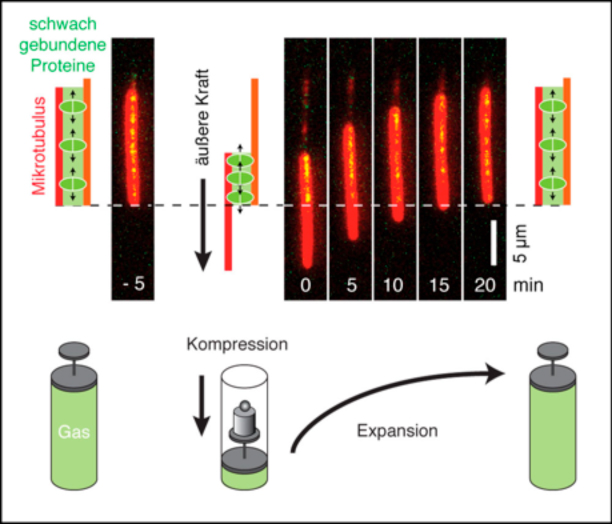Biomolecular force generation based on the principle of a gas spring

The expansion of compressed, weakly bound proteins (green) leads to a force that causes the directional movement of two overlapping microtubules against one another. Prof. Dr. Stefan Diez
When cells divide, their genetic information is passed on to both daughter cells in a highly complex process. Thereby, an important role is played by small, cylindrical protein tubes, called microtubules. They form the scaffold of the spindle apparatus helping to distribute the genome in the chromosomes to the two daughter cells when cells divide.
Besides their mission of docking onto the chromosomes directly and pulling them apart, microtubules are also of great importance for stabilizing the spindle apparatus. To this end the microtubules overlap at the centre of the cell, connecting the opposite spindle poles.
When cells divide, it can be observed that these overlapping microtubules are initially made to slide in relation to one another by so-called motor proteins, but then stop before actually separating. Until now, scientists have only been able to explain the mechanism that inhibits their movement and stops the sliding in parts.
In cooperation with scientists from the Netherlands (Wageningen University and AMOLF), an international group of scientists around Professor Dr. Stefan Diez (Heisenberg Professor at ZIK B CUBE – Center for Molecular Bioengineering at TU Dresden, and group leader at the Max Planck Institute of Molecular Cell Biology and Genetics) has now been able to show that a well-known principle of physics is also relevant in biology: Weakly binding proteins which preferably accumulate between overlapping microtubules behave like diffusing gas particles in a closed container.
Those gas particles respond with rising pressure to a reduction in volume. This simple principle, as familiar from the ideal gas law as it is from common household bicycle pumps, is also how the weakly binding proteins create an ever growing counter-pressure between the overlapping microtubules as they slide apart. This causes the movement to decelerate and stops the sliding. This biomolecular mechanism corresponds to the principle of a gas spring .
The scientists have been able to demonstrate this mechanism in experiment and theory. They have also successfully managed to directly measure the resulting forces by means of optical tweezers. And they have finally been able to show that the gas-like pressure of the weakly binding proteins is strong enough to compensate the power of the motor proteins and keep the overlapping microtubules from falling apart.
This not only means that a minimal mechanism for stabilizing overlapping microtubules has been found and experimentally proven, but also that a further generally applicable mechanism has been added to the repertoire of cell biological mechanisms of action.
The study was published online in the renowned scientific journal “Cell” on 5 March 2015 and will appear in the printed issue on 12 March 2015.
Original publication:
Zdenek Lansky, Marcus Braun, Annemarie Lüdecke, Michael Schlierf, Pieter Rein ten Wolde, Marcel E Janson, Stefan Diez, Diffusible crosslinkers generate directed forces in microtubule networks, DOI:10.1016/j.cell.2015.01.051
Information for journalists:
Prof. Dr. Stefan Diez
Heisenberg-Professorship for BioNano Tools
Technische Universität Dresden
ZIK B CUBE – Center for Molecular Bioengineering
Tel.: +49 (0) 351 463 43010
Fax: +49 (0) 351 463 40322
stefan.diez@tu-dresden.de
http://www.tu-dresden.de/bcube
About B CUBE at the TU Dresden
The Center for Innovation Competence (ZIK) B CUBE – Center for Molecular Bioengineering was founded in 2008 in conjunction with funding by the BMBF-program „Unternehmen Region“. The center is dedicated to investigate and engineer biological materials along the three main axes BioProspecting, BioNano Tools and Biomimetic Materials, thereby contributing significantly to the profile of the TU Dresden in the fields of modern biotechnology and biomedicine.
Caption: The upper part of the figure shows a schematic diagram of the movement of two overlapping microtubules (red and orange) in combination with typical fluorescence microscopy images. The lower part of the figure shows a gas spring, the macroscopic counterpart of the biomolecular system, where gas is compressed by the impact of an external force and expands again later as soon as the external force is reduced.
Media Contact
All latest news from the category: Life Sciences and Chemistry
Articles and reports from the Life Sciences and chemistry area deal with applied and basic research into modern biology, chemistry and human medicine.
Valuable information can be found on a range of life sciences fields including bacteriology, biochemistry, bionics, bioinformatics, biophysics, biotechnology, genetics, geobotany, human biology, marine biology, microbiology, molecular biology, cellular biology, zoology, bioinorganic chemistry, microchemistry and environmental chemistry.
Newest articles

A ‘language’ for ML models to predict nanopore properties
A large number of 2D materials like graphene can have nanopores – small holes formed by missing atoms through which foreign substances can pass. The properties of these nanopores dictate many…

Clinically validated, wearable ultrasound patch
… for continuous blood pressure monitoring. A team of researchers at the University of California San Diego has developed a new and improved wearable ultrasound patch for continuous and noninvasive…

A new puzzle piece for string theory research
Dr. Ksenia Fedosova from the Cluster of Excellence Mathematics Münster, along with an international research team, has proven a conjecture in string theory that physicists had proposed regarding certain equations….



